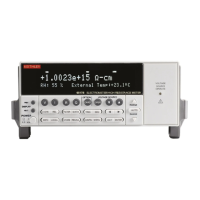Model 6517B Electrometer Reference Manual Section 14: SCPI command reference
6517B-901-01 Rev. C / August 2015 14-109
:PTRansition <NRf>
This command is used to program filters.
Usage
:STATus:MEASurement:PTRansition <NRf>
:STATus:QUEStionable:PTRansition <NRf>
:STATus:OPERation:PTRansition <NRf>
:STATus:OPERation:TRIGger:PTRansition <NRf>
:STATus:OPERation:ARM:PTRansition <NRf>
:STATus:OPERation:ARM:SEQuence:PTRansition <NRf>
:PTRansition?
<NRf>
1: Set Bit B0
2: Set Bit B1
4: Set Bit B2
8: Set Bit B3
16: Set Bit B4
32: Set Bit B5
64: Set Bit B6
128: Set Bit B7
256: Set Bit B8
512: Set Bit B9
1024: Set Bit B10
2048: Set Bit B11
4096: Set Bit B12
8192: Set Bit B13
16384: Set Bit B14
32768: Set Bit B15
Details
These commands are used to program the positive transition (PTR) registers. A positive transition is
defined as a 0 to 1 state change in the condition register. Thus, when an event is programmed for a
positive transition, the appropriate bit in the corresponding event register sets when the
corresponding bit in the condition register changes from 0 to 1. For example, if Bit B9 of the positive
transition register of the transition filter transition filter is set, then the buffer full event is programmed
for a positive transition. The BFL bit (B9) in the transition filter event register sets when the trace
buffer becomes full. For details on register structure, see Status structure.
The PTR registers are shown below. Included is the decimal weight of each bit. The sum of the
decimal weights of the bits that you wish to set is the parameter (<NRf>) that is sent with the
command. For example, to program RAV (B5) and BFL (B9) measurement events for positive
transitions, send the following command:
:stat:meas:ptr 544
Where: BFL (Bit B9) = Decimal 512
RAV (Bit B5) = Decimal32
<NRf> = 544
Positive transition effect on transition filter event register
Measurement event Positive transition effect on transition filter event register

